欧博abgOcean Exploration Timeline on Sea and Sky

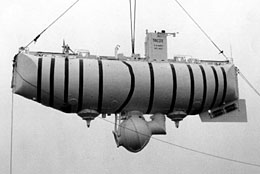
Wikipedia Public Domain Image
January 23, 1960
Deepest Ocean Dive
Jacques Piccard, son of explorer August Piccard, and two other men descend into the ocean to a depth of 35,797 feet (10,911 meters), nearly seven miles. They make the trip in the Trieste, a sturdy underwater vehicle known as a bathyscaphe. Trieste was designed by Piccard and built several years earlier. The divers discover fish and other amazing deep-sea life at these tremendous depths.

1961
Tow System Developed
The Scripps Institution of Oceanography begins development of the Deep Tow System. This sonar system becomes the forerunner of all remotely-operated and unmanned oceanographic systems today.

1962
First Underwater Habitat
Several experiments are conducted whereby people live in underwater habitats. The researchers leave the habitat for exploration and return again for food, sleep, and relaxation. The habitats are supplied by compressed air from the surface. In the first such experiment, Conshelf (Continental Shelf) One, Jacques Cousteau and his team spend seven days under 33 feet of water near Marseilles, France, in a habitat they name Diogenes.

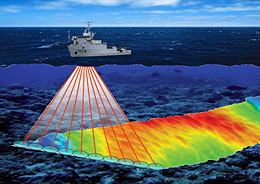
NOAA Photo Library / CC BY 2.0
1963
First Multibeam Sounding
The first operational multibeam sounding system is installed on the USNS Compass Island. This system observes a number of sounding beams to the left and right of a ship's head as well as vertically. This allows the development of a relatively accurate map of the sea floor as the ship proceeds on a survey line.

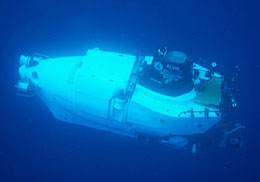
NOAA Public Domain Image
1964
Deep Sea Submersible Alvin
Alvin, a new deep submergence vehicle, is constructed by the Woods Hole Oceanographic Institute. It is the first U.S. deep diving submersible and the first deep-sea submersible capable of carrying passengers. Later that year, Alvin explores the Cayman Trough, the deepest point in the Caribbean Sea. Alvin becomes one of the most famous deep sea vehicles, making over 4,000 dives during its lifetime.

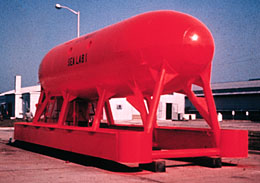
NOAA Public Domain Image
July 20, 1964
Sealab 1 Deployed
Sealab 1 is the first experimental underwater habitat developed by the Navy to research the psychological and physiological strain of extended periods spent living and working underwater. It is deployed off the coast of Bermuda at a depth of 192 feet (59 meters) below the ocean surface. Sealab 1 proves that saturation diving in the open ocean is viable for extended periods. It is currently on display at the Museum of Man in the Sea, in Panama City Beach, Florida

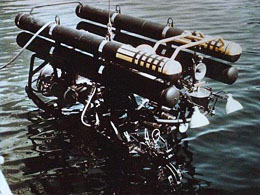
U.S. Navy Photo
1965
First Underwater Robot
The Navy develops the Cable-controlled Underwater Recovery Vehicle (CURV). It is developed by the former Pasadena Annex of the Naval Ordnance Test Station to recover test ordnance lost off San Clemente Island at depths as great as 2,000 feet (610 meters). It is designed to find and retrieve torpedoes it used in tests and training but becomes famous in 1966 when it recovers an H-bomb off Spain in 2,800 feet (853 meters) of water.

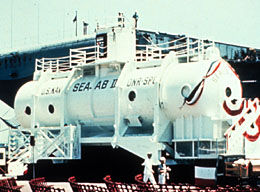
U.S. Navy Public Domain Image
October 1, 1965
Sealab 2 Deployed
Sealab 2 is deployed in the La Jolla Canyon off the coast of Scripps Institution of Oceanography in La Jolla, California, at a depth of 205 feet (62 meters). It is twice the size of Sealab 1 and is designed to house ten men at a depth of 200 feet (61 meters) for 30 days. It contains heating coils in the deck to ward off the constant helium-induced chill, and air conditioning to reduce humidity.


Public Domain Image
August, 1968
Deep Sea Drilling Program
The deep sea research vessel Glomar Challenger departs on a 15-year expedition known as the Deep Sea Drilling Program. The ship criss-crosses the Mid-Atlantic Ridge between Africa and South America taking core samples. The ages of the samples provide solid evidence for the theory of seafloor spreading, which will eventually give rise to the modern theory of plate tectonics.

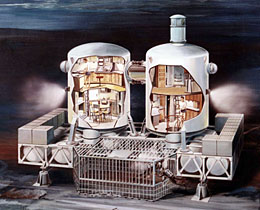
NOAA Public Domain Image
January 28, 1969
Tektite Undersea Laboratory Deployed
The Tektite project begins as an underwater laboratory is lowered in to the water in Great Lameshur Bay, Saint John, U.S. Virgin Islands. Designed and built by General Electric Company, Tektite consists of two metal cylinders connected by a flexible tunnel. A team of four divers spend 60 days inside the habitat at a depth of 50 feet (15 meters). During the course of the project, over 60 scientists and engineers will live and work beneath the sea.

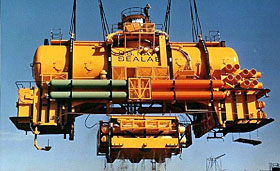
Public Domain Image
February 15, 1969
Sealab 3 Deployed
Sealab 3 is deployed off the coast of off San Clemente Island, California at a depth of 610 feet (185 meters). It uses the refurbished Sealab 2 habitat and is placed in water three times deeper. The habitat soon begins to leak and four divers are sent to repair it but are unsuccessful. During a second attempt, one of the divers is killed due to a faulty rebreather. It is believed that someone aboard the command barge is trying to sabotage the habitat's air supply. A suspect is identified but never prosecuted. Sealab 3 is retrieved from the ocean floor and scrapped.

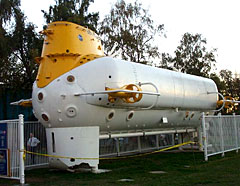
Wikipedia Public Domain Image
July 14, 1969
First Long Duration Submersible Expedition
A manned underwater submersible known as the Ben Franklin spends 30 days submerged off the coast of Palm Beach, Florida. A six-member crew led by the vehicle's creator, Jacques Piccard, study the Gulf Stream and travel a total distance of 1,444 miles (2,324 km). The voyage also serves to study the effects of long-term, continuous close confinement for long space flights.